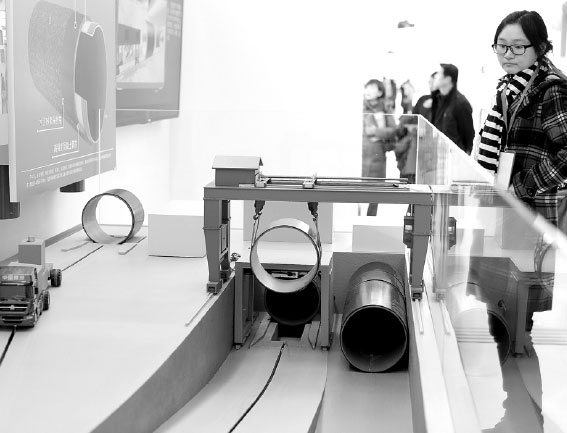China's new grand canal brings water to arid north
Updated: 2014-12-16 08:00
By Xinhua(China Daily USA)
|
||||||||
Largest project of its kind, proposed in 1952, took more than a decade to construct
More than 1,400 kilometers of canal and pipeline began transferring water on Friday from China's longest river, the Yangtze, to the country's arid northern regions, including the nation's capital, Beijing.
Completion of this section marks major progress in the enormous South-to-North Water Diversion Project, costing an estimated 500 billion yuan ($80 billion) and the largest of its kind in the world.
President Xi Jinping sent his congratulations on Friday to workers and people "who have made contributions" to the middle route project, calling the achievement a "major event" in the nation's modernization drive.
He said the success has come through ceaseless effort by hundreds of thousands of people since construction started on Dec 30, 2003. More than 200,000 workers participated in the construction.
Xi described the project as important strategic infrastructure that would optimize water resources, boost sustainable economic and social development, and improve people's livelihoods.
The south-north water diversion project is another feat of Chinese engineering, in the style of the Beijing-Hangzhou Grand Canal, the world's longest man-made river, constructed in the 13th century to transport grain between the south and north.
Water will eventually flow via eastern, middle and western routes along canals, pipelines and tunnels. It took eight years for engineers and workers to complete two 4,000-meter-long tunnels under the riverbed of the Yellow River, China's second largest.
The first-stage of the project, the eastern route, went into operation last year, sending water to Shandong province. By 2050, as many as 440 million people could benefit from the diversion of 44.8 billion cubic meters of water each year.
The middle route begins at Danjiangkou reservoir, in Hubei province, and runs for 1,432 km. It will supply 9.5 billion cu m of water per year to some 100 million people in the dry northern regions, including the cities of Beijing and Tianjin, and provinces of Henan and Hebei.
The water will meet household, industrial and agricultural demand, benefiting more than 100 counties.
President Xi urged the route's management to protect the quality of water and to save water.
Work still needs to be done to ensure the livelihoods and employment of the 400,000 people displaced by the construction, including 345,000 people whose hometown was submerged as part of the massive Danjiangkou reservoir.
Premier Li Keqiang said the project will benefit both current and future generations, and urged the project management team to ensure the security and stability of supply.
The project was conceived by late Chinese leader Mao Zedong in 1952 but only approved by the State Council in December 2002, after nearly half a century of debate.
It has been widely hailed as an example of how the Chinese people are capable of bettering their lives through hard work. But the new waterway presents fresh challenges, such as the protection of water quality from unforeseen natural risks in the future.
|
An exhibition about the middle route of China's South-to-North Water Diversion Project opened at the Capital Museum in Beijing on Friday to honor those who contributed to the enormous engineering project and remind the public to cherish the country's water resources. Wang Jing / China Daily |
(China Daily USA 12/16/2014 page6)

 'Early Mona Lisa' traced to English country home
'Early Mona Lisa' traced to English country home
 China deepens Americas ties signing pacts
China deepens Americas ties signing pacts
 Chinese premier arrives in Kazakhstan for visit, SCO meeting
Chinese premier arrives in Kazakhstan for visit, SCO meeting
 People hold candles to mourn victims of Nanjing Massacre
People hold candles to mourn victims of Nanjing Massacre
 2014 Toronto Santa Speedo Run held in Canada
2014 Toronto Santa Speedo Run held in Canada
 Life on his father's back
Life on his father's back
 Village of hand-made noodles
Village of hand-made noodles
 Fire engulfs ethnic village in SW China
Fire engulfs ethnic village in SW China
Most Viewed
Editor's Picks

|

|

|

|

|

|
Today's Top News
Obama vows no safe haven for Islamic State
Youth in US, China building trust
Gunman in Sydney hostage taking known to Federal Police
China demotes 1,000 officials with family abroad
China's new grand canal brings water to arid north
Family of wrongly killed man may get $193,860: media
Denmark claims North Pole via Greenland ridge link
Manager of Sydney Cafe dies as hero in hostage siege
US Weekly

|

|








